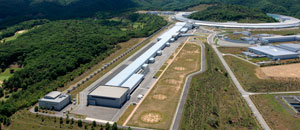Feb. 9, 2018 Research Highlight Chemistry
A light touch for enzyme analysis
Femtosecond x-ray crystallography captures key moments of an essential biochemical process triggered by light
 Figure 1: Researchers at RIKEN used the SACLA X-ray free-electron laser (photo) at RIKEN’s SPring-8 facility to reveal the nitric oxide substrate adopts a bent structure in the enzyme’s active site. © 2018 RIKEN
Figure 1: Researchers at RIKEN used the SACLA X-ray free-electron laser (photo) at RIKEN’s SPring-8 facility to reveal the nitric oxide substrate adopts a bent structure in the enzyme’s active site. © 2018 RIKEN
A technique developed by RIKEN researchers that uses ultraviolet light and x-rays to observe enzymes in action could provide new insights into essential processes for life1.
Enzymes are nature’s catalysts, driving many of the biochemical transformations that sustain life. Conventional x-ray crystallography uses a steady beam of x-rays to probe a molecule’s structure, but it cannot capture the dynamic structures of enzymes.
X-ray free-electron laser (XFEL) crystallography uses a particle accelerator to produce x-ray beams so intense that a pulse just a few femtoseconds (million billionths of a second) long can capture an enzyme’s structure. A series of ultrashort x-ray pulses can potentially take a series of snapshots as the protein interacts with its natural substrate.
Takehiko Tosha at the RIKEN SPring-8 Center and his co-workers have developed a new way to control this process. Rather than simply mix enzyme and substrate together and hope to catch the interaction at the crucial moment, the team developed a ‘caged’ version of the substrate, which releases the substrate on exposure to ultraviolet light.
“The caged substrate makes it much easier to control the timing of the reaction initiation than the mixing method,” Tosha says. “That’s because in the mixing method it takes time for the substrate to diffuse into the protein crystals, whereas the caged substrate releases the substrate on a microsecond timescale on being illuminated by ultraviolet light.”
The team demonstrated their technique by using it to study the interaction of an enzyme present in a common soil fungus with its nitric oxide (NO) substrate, which the enzyme reduces to nitrous oxide (N2O)—an important reaction in the nitrogen cycle.
The researchers used the caged substrate to study the initial intermediate that forms between nitric oxide and the enzyme. The XFEL crystallographic images they captured revealed that, as the nitric oxide bonds to the iron (Fe) atom in the enzyme’s active site, it adopts a bent structure (Fig. 1).
“The geometry of the Fe–N–O unit modulates its electronic structure,” Tosha explains. “The nitric oxide dissociation reaction is suppressed by the bent character of the Fe–N–O unit.” The bent structure keeps the nitric oxide unit in place within the enzyme.
“We have demonstrated that the combination of XFEL and a caged compound is invaluable for observing enzymatic reactions at an atomic level,” Tosha says. The team plans to use their technique to explore the next step of the reduction of nitric oxide, as well as to study other enzyme–substrate combinations.
Related contents
- Using super-slow motion movie, scientists pin down the workings of a key proton pump
- Brighter, shorter x-ray pulses to share
- Shining a gentle light on photosynthesis
References
- 1. Tosha, T., Nomura, T., Nishida, T., Saeki, N., Okubayashi, K., Yamagiwa, R., Sugahara, M., Nakane, T., Yamashita, K., Hirata, K. et al. Capturing an initial intermediate during the P450nor enzymatic reaction using time-resolved XFEL crystallography and caged-substrate. Nature Communications 8, 1585 (2017). doi: 10.1038/s41467-017-01702-1
